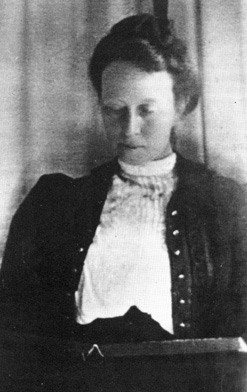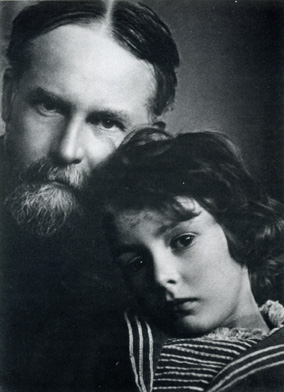|
F. W. H. Myers died in 1901, which was one year after the death of Professor
Henry Sidgwick.
Gurney's death had come, tragically, by possible suicide some years before.
The SPR leadership now fell into the hands of a team of new intellects headed by
Alice Johnson, who was a protégé of Professor
Sidgwick's wife, and
J. G. Piddington, a scholar and barrister who soon devoted his full
attention to psychical research. These researchers threw themselves into the
study of the
Piper mediumship, but they also began working with several other trance
psychics who appeared on the scene. Chief among these were Mrs
Margaret Verrall, the wife of a Cambridge professor of classics, and her own
daughter Helen. Both of them were well aware of the SPR's work before they
actually developed their own mediumships. The SPR also found itself studying the
automatic writings of Rudyard Kipling's sister in India, whom they identified
only as 'Mrs
Holland' in their reports on her. She actually contacted them when
she found herself suddenly receiving automatic writing from the surviving F. W
H. Myers! The last of this group of new trance mediums was a woman only called 'Mrs
Willett' in the reports and who was one of the most talented of the group.
It wasn't until years after her death that her identify was revealed as Mrs
Winifred Coombe-Tenant, a prominent British stateswoman of the time. It was
extremely lucky that the SPR was able to find so many talented mediums, for it
appeared that the deceased founders of the Society were themselves eager to
establish communications from beyond the veil.
That these eminent scholars should seek to contact their colleagues is not
surprising but what was surprising was the nature of their
communications. Sometimes one of the psychics, working alone at home, would
scribble a message that made little sense, but which seemed to relate to what
one of the others was writing at about the same time. These messages often
seemed to be coming from the deceased Myers. Piddington and Johnson realized
very quickly that curious jig-saw puzzles were being communicated through the
scripts; for when the messages were joined together, an important communication
would be spelled out. These puzzles were immediately called the
'cross-correspondences' and represent a very important chapter in the literature
on trance mediumship. They went on for years, and it appeared as though Myers
was devising his own very personal way of proving his continued survival to the
colleagues he had left behind.[9]
[9] Saltmarsh, H. F. Evidence of Personal
Survival from Cross-Correspondences. London: Bell, 1938.
 |
|
Mrs Margaret Verrall was the protagonist of the
'cross correspondences' which she felt were the deliberate handiwork of a single
personality, that of the recently deceased F. W. H. Myers. (Mary Evans Picture
Library)
|
 |
|
F. W. H. Myers with his son Harold. (Mary Evans Picture Library) |
Some of the cross-correspondences became enormously
complex, since Myers was in the habit of drawing his material and citations from
classical Greek and Latin literature. Most of the mediums were ignorant of this
body of literature, but Myers was an authority on it, so his choice was
certainly a propos. One of the easier cases to follow is the case of the
Medici tombs, which the soi-disant Myers communicated through several SPR
sensitives in 1906. The cross-correspondence first came to light when Mrs
Holland was visiting England that year. Some of her private scripts of that
period contained messages from Myers alluding to death, sleep, shadows, dawn,
evening and morning. No clues to the meaning of these themes were given except
that the name 'Margaret' (Verrall) was appended.
Such cryptic allusions immediately suggested that a cross-correspondence case
was in the works; so upon learning about the scripts, Alice Johnson and
Piddington started checking the writing their other psychics were producing and
sending to them. Since Mrs Piper was also visiting England at this same time, J.
G. Piddington sat with her a few months later and she spoke the following words
while emerging from trance: 'Morehead - laurel for laurel. I say give her that
for laurel. Goodbye.' She also saw the apparition of a negro. This really didn't
make all that much sense either, so Piddington held another session with Mrs
Piper the very next day. During this séance Myers communicated directly and
explained that the key to the cryptic message could be found by examining Mrs
Verrall's scripts. (Remember that this same message was alluded to in Mrs
Holland's germinal scripts). It turned out that the discarnate Myers was a
little off the mark, for the next allusions to the puzzle came in Helen
Verrall's scripts written in Cambridge. She followed up on the laurel theme by
writing one day: 'Alexander's tomb - laurel leaves, are emblems, laurels for the
victor's brow.' Mrs Holland was also still under the influence of the alleged
Myers, for shortly after the Verrall scripts arrived, she found herself writing
one evening: 'Darkness, light, shadow, Alexander Moor's head.' It should be
noted that none of the psychics was in contact with any of the others.
There seems little doubt but that these messages were all interrelated, though
they probably will make little sense to the modern reader. But the SPR leaders
were versed in classical literature and history, and the allusions made
considerable sense to them. The final key came when Mrs Willett contacted the
SPR with some of her own automatic writings, which contained the words: 'Laurential
tomb, Dawn and Twilight'.
It was now apparent that all these messages referred to the tombs of the Medici
family in Italy. J. G. Piddington explains in his report on this
cross-correspondence that the laurel was the family emblem of Lorenzo, the
Magnificent, a one-time patriarch of the Medicis. Other symbols carved on the
family tombs represent dawn and twilight. The allusion to Alexander was not too
puzzling either, since Alessandro de Medici had been another member of the
family. He was known as 'The Moor' because of his mulatto heritage, and he was
secretly buried in the Medici tombs.
One interpretation of this case, then, is that the
deceased Myers used his knowledge of the tombs to inject a literary jig-saw
puzzle into the scripts of the mediums. This was the type of information with
which Myers was well conversant but which was beyond the education of some of
the psychics.
The case of the Medici tombs is actually a rather simple and compact one. Some
of the other cross-correspondences were much more complex and took years to
complete. The pinnacle of the cross-correspondences probably came in 1906 when
Mrs Piper was still in England. During one of his sittings with her, Piddington
delivered a specially constructed message to the purported Myers which set the
stage for it. He explained to 'Myers' through Mrs Piper: 'We are aware of the
scheme of the cross-correspondences which you are transmitting through various
mediums; and we hope that you will go on with them. Try to give to A and B two
different messages, between which no connection is discernible. Then as soon as
possible give to C a third message that will reveal the hidden suggestions'. He
also proposed that Myers designate his allusions to the cross-correspondence by
signing the pertinent scripts with a triangle transcribed within a circle.
Now there was an important catch to this massage, for it was read to the
entranced medium in Ciceronian Latin. Mrs Piper, of course, understood no
Latin and especially not such an obscure dialect, but the language was well
within the command of the living Myers. Mrs Piper's controls responded to the
message by saying they understood.
It took only a few weeks for the deceased Myers to spell out this complicated
cross-correspondence. Between 17 December and 2 January allusions of the themes
of stars, hope, and the poetry of Robert Browning started cropping up in the
writings of Mrs Verrall and her daughter. These allusions made little sense to
Piddington until he received a message at a sitting with Mrs Piper in London to
'look out for Hope, Star, and Browning. The allusions then all made sense when
Piddington read up on Browning and found that the cross-correspondence related
to themes contained in his poem Abt Vogler.
The cross-correspondences went on for years, and gradually began ebbing in the
1910s. The SPR leaders found them very convincing evidence for survival,
although they tend to be very problematic for the modern student. The greatest
difficulty with the cross-correspondences was that it took a great deal of
classical scholarship to fully appreciate them. Writing in 1972, Dr
Robert Thouless - a British psychologist and an authority on the survival
problem - went so far as to suggest that, 'if this was an experiment devised ...
on the other side of the grave, I think it must be judged to be a badly designed
experiment. It has provided a mass of material of which it is very difficult to
judge the evidential value, and about which there are varying opinions.'[10]
[10] Thouless, Robert. From Anecdote to
Experiment in Psychical Research. London: Routledge and Kegan Paul, 1972.
Dr Thouless's verdict is a little harsh, but it echoes the sentiments of many
contemporary researchers. It is nonetheless important to note that those
researchers who studied the cross-correspondences most intensely came to see
them as strong and almost irrefutable evidence for life after death. The only
exception was the always sceptical
Frank Podmore, who believed that telepathy among the sensitives could
explain them. He especially focused on Mrs Verrall as the source of the leakage,
since she alone among the psychics had a good background in the classics.
Next part (6): New Developments in Research on Mediumship
More parts to this article:
Part 1: The Case of James Kidd
Part 2: The Foundations of Survival Research
Part 3: Apparitions and the Case for Survival
Part 4: Mediumship and the Case for Survival
Part 5: Cross-correspondences (current page)
Part 6: New Developments in Research on Mediumship
Source:
D. Scott Rogo's "Life After Death. The Case
for Survival of Bodily Death" (London: Guild Publishing, 1986).
|

